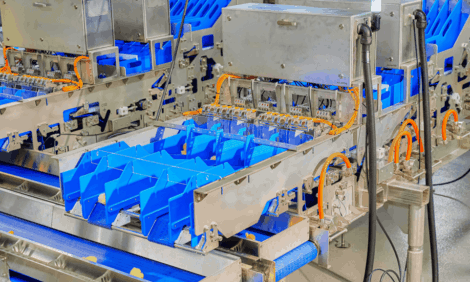



Water Quality and Broiler Performance
Algae, bacteria, rust, and other contaminants can build up on the inner surfaces of poultry house water lines over time, Marco Quiroz, DVM, Manager of Product Development at Novus International Inc told the University of North Carolina supervisors short course earlier this year.Although flushing water lines between flocks is recommended, flushing cannot always remove the slime layer or bio-film of bacteria or algae. Therefore, more poultry growers are incorporating some form of organic acids to their water-system flushing procedures. In addition to suppress bio-film formation in the water lines, this procedure will reduce harmful bacteria, improve animal performance as well as food safety.
From feed formulation to delivery, great attention has been paid to the feed your bird receives. Poultry nutritionists have fine-tuned their feed formulations based on years of research and how this research performs in the field. Hence today’s rations contain nutrients in amounts and proportions that support optimum bird performance. Feed manufacturers place great importance on feed and pellet quality while ingredient purchasers set strict standards to assure consistent ingredients are purchased every time. Poultry producers maintain secure storage facilities to protect the quality of the feed delivered to their birds. Although feed quality has received much attention, the quality of the water that birds drink is often overlooked.
Substandard water quality – water contaminated with microorganisms, algae, dust, and rust -- is relatively common and can have a profound adverse impact on poultry performance. In some aspects, water quality can have a greater negative effect on bird performance than feed quality because it is a well known fact that birds consume more water than they consume feed.
According to several studies, more than 40 percent of privately owned individual drinking water supplies – typically found on U.S. poultry farms -- are contaminated with coliform bacteria. In some regions of the world, more than 70 percent of the water supplies are contaminated with coliform bacteria. The microorganisms can enter a water supply from a variety of sources including sewage, animal wastes, or dead animals.
Although some of the microorganisms found in the drinking water can be potentially harmful, others are not. For example, iron bacteria are a major nuisance in many well-water supplies. (Iron bacteria should not be confused with iron dissolved in water that causes red water and stains on clothing and plumbing fixtures.) Iron bacteria do not cause disease, but do form a reddish-brown slime that coats the inside of pipes, fouls pumps, and clogs waterers. All of which represent a major challenges for poultry growers.
Algae are another type of microorganism that contaminates poultry water supplies. Some algae produce compounds which are toxic to poultry. In extreme cases, algae-produced compounds cause offensive flavors -- described as “muddy” or “plastic” -- in poultry meat.
Because bacteria- and algae-contaminated water may cause disease -- or in some cases, depress the bird’s immune system -- poultry flock performance suffers. In addition, some non-pathogenic bacteria and algae impart an offensive odor or taste to the water, which in turn results in water refusal, leading to a drop in feed intake and poor bird performance.
A major contributing factor to the presence and intensity of bacteria or algae contamination in poultry drinking water is the amount of dissolved nutrients – specifically phosphorus and nitrogen -- in the water. These nutrients facilitate the growth of bacteria and algae through a biological process known as eutrophication.
In a major study conducted several years ago by the U.S. Geological Service at the Massachusetts Military Reservation near Cape Cod, researchers concluded that the phosphorus was a common cause of eutrophication. Over time, eutrophication can progress to a point where the bacteria or algae form a visible slime layer – or bio-film -- on the inside surface of water pipes.
Poultry growers find that water-borne bacteria and algae are difficult to kill. The cells of these microorganisms are encased in a cell wall. Common disinfectants and sanitizers cannot penetrate or degrade the cell wall. Bio-films provide bacteria and algae with additional protection from chemical assaults.
“Bio-film is generally present in all watering systems and the only good way to suppress mature bio-films is to aggressively ‘shock’ water lines with a good sanitizing agent between flocks,” Dr. Pat Welch, a poultry production consultant, says.
The aim of a water-system shock treatment is to expose all interior surfaces of the drinking water system to a sanitizing agent for a sufficient period of time to reduce the surface tension of the bio-film and dissolve mineral deposits that have accumulated in the water lines, and kill potential vegetative bacteria and algae growing in the bio-film.
Welch cautions poultry growers to exercise care when mixing acids (organic or inorganic) and detergents with chlorine products due to the release of chlorine gas which can be harmful if exposed to the eyes or upper respiratory tract. “If inhaled in sufficient quantities, (chlorine gas) can be fatal,” he warns. Welch advises poultry growers to don personal protective equipment before using oxidizers to shock water lines. Also, some oxidizers used for shocking water-lines are caustic and cause chemical burns on exposed skin or mucous membranes.
More poultry growers are discovering the value of water quality on the performance of chickens, turkeys, ducks, and other commercial poultry. In a 2006 survey of growers conducted by Terrance O’Keefe and Gary Thornton, 33 percent of U.S. broiler growers responded that acidification of drinking water was one of the most promising new technologies on the farm. The percent was higher – nearly 42 percent -- for turkey growers. Nearly 66 percent of broiler growers said drinking water treatment – acidification or chlorination -- was one of the most effective ways of controlling microorganisms in poultry operations – higher than the effectiveness of vaccines and direct-fed microbials.
Yet, all acidifiers are not the same. An important distinction must be made between acidifying water versus reduction of microorganisms in the water, performance and food safety. For example, citric acid is an organic acid commonly used by poultry producers for acidifying their water. Citric acid is an excellent acid for this mainly because it’s inexpensive but also because it contains three carboxyl groups which help decrease the pH of the water quickly. pH of the water is important when you are using sanitizers, because lower pH allows sanitizers to be more effective against certain microorganisms. However, citric acid does not have good antimicrobial activity.
HMTBA (2-hyroxy 4-methlythio butanoic acid) is an organic acid and amino acid precursor (ALIMET® feed supplement by Novus International, Inc.). Research conducted by the CCL Institute in the Netherlands using HMTBA demonstrated its effectiveness in reducing bacterial populations such as Salmonella, E.coli and Campylobacter, all of which can be found in the drinking water of poultry (report CCL-FS/QS 04.0058). HMTBA is also one of the main components of ACTIVATE® WD MAX, a proprietary blend of organic acids from Novus International. While in the water, but more importantly, once consumed by the birds ACTIVATE WD MAX plays an important role in the destruction of harmful microorganisms that could affect the birds future performance and that also play a role in food safety concerns.
Hence a new two-step poultry water shock and cleaning procedure followed by the addition of ACTIVAT WD MAZ is outlined in Table 1. Table 2 features a list of chemicals suggested by Dr. Welch that can be used when shocking and cleaning the water lines prior to placing birds in the house.
Table 1. A procedure for shocking water lines with organic acids and detergent in commercial poultry houses.
Step 1: Raise the water lines to approximately three-feet off the ground.
Step 2: Turn off the water service from the source and drain the entrained water from the lines by opening the ends of the lines.
Step 3: Shock solution recipe: Add three ounces of liquid dishwashing detergent (unbuffered and unscented) and three ounces of blue food color to one gallon of a solution (65-85 percent) of organic acids or prepare a stock solution just by adding 250g of Citric acid/liter of stock solution and mix thoroughly.*
Step 4: Open the water regulators to the “Flush” mode to accelerate the shock solution through the water line.
Step 5: With a medication metering pump, dispense the shock solution though the water line – including the hoses used to fill the drinkers -- at a rate of one ounce per gallon.
Step 6: Turn off the regulators and then close the ends of the water lines**
Step 7: Allow the shock solution to remain in the water line and drinkers for approximately 90 minutes.
Step 8: Purge the water lines with Hydrogen peroxide 35% (1 oz/gallon) of Peroxyclean® 50% pull directly from the container to the medicator. Allow the solution to remain in the water lines for approximately 24-48 hours.
Step 9: walk through the house and drag the bristles of a broom along the bottom of the waterlines triggering each nipple allowing the solution to penetrate the nipple assembly.
Step 10: 24 hours before placement of new flock, Prepare a solution of Activate WD MAX ***, a proprietary blend of organic acids from Novus International for drinking water applications, according to directions, and flush the water line. Do not add blue food color to this solution.
Step 11: Measure the pH of the water at the end of the water line. It should be less than 3.5, the optimum pH for Activate WD to have a maximum antibacterial effect.
* The shock solution will be dark blue. Once it has traveled through the entire water line, a light blue solution will be observed coming out of the end of the water line. Once this occurs, allow 2.5 gallons of water to flow out of the water line to ensure that undiluted shock solution is present in the entire water line. If bell drinkers are used, it is essential that undiluted shock solution flows into the bell drinker. This may require emptying the drinkers
several time before the blue shock solution is observed. When the shock solution appears, allow the shock solution to fill the drinkers to the lip to sanitize the drinkers.
** When using the regulator set on “Flush,” the procedure can damage the diaphragm if the regulator is not turned off before closing the drain vales at the end of the water line.
***Activate WD is different from other organic acid blends because it includes Alimet® feed supplement.
Table 2. Effective chemicals for poultry house water-line shock treatments.
| Chemical | Effective concentration Chemical (ml or g per liter) |
|---|---|
| Acetic acid (vinegar), 5% | 1,000 |
| Ammonia (household) | 125 |
| Anthium dioxide, 5% | 13 |
| Buffered organic acids, 65-85% | 1,000 |
| Chloride, 6% bleach | 125 |
| Citric acid, 410 g/pk | 250 |
| Hydrogen peroxide, 50% | 1,000 |
| Sodium acid sulfate | 125 |
| Sodium chlorite, 0.2% | 47 |
| Virkon* S | 10 |
Virkon S is a DuPont product
Poultry growers will likely find the task of maintaining high-quality water supplies more challenging in the future. Higher temperatures – possibly due to global warming – decreased precipitation, and the reduced flow of surface and ground water could concentrate contaminants (nutrients) in drinking water. This will lead to faster, more widespread, and higher intensity eutrophication. Higher environmental temperatures will also accelerate bacteria and algae growth in water lines. Therefore, the best defense is for poultry producers to establish procedures – such as chemical shock treatments -- to suppress the formation of bio-films and slime layers in their poultry water lines followed by the use of organic acids like ACTIVATE WD MAX for controlling harmful bacteria. These practices are an important piece of a program for improved water quality, improved live performance and improved food safety.
May 2008









